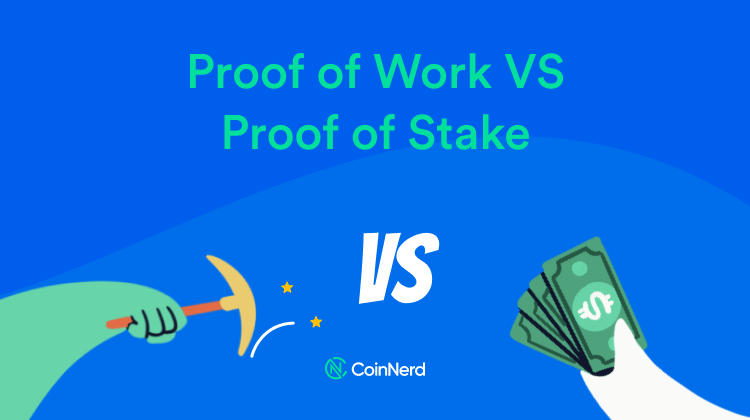A Guide on How To Stake ETH and Other Important Details
Are you curious about how to stake ETH? This article contains everything you need to know about staking as well as information that you need to get started on staking.
What is Staking?
To earn rewards or interest, crypto holdings are staked. To create a cryptocurrency, blockchain technology is used to verify and record crypto transactions, and this data is stored on a distributed ledger. Validating blockchain transactions is also known as staking.
According to the type of cryptocurrency you’re working with, these validation processes can be referred to as “proof of stake” or “proof of work,” depending on the supporting technologies. Confirmation that a network’s transaction data adds up as expected is made possible by each of these processes.
However, participants are required to reach this agreement. Participants in the consensus-taking processes of these networks are staking, or actively holding on to, or locking up, their crypto holdings. Stakers, in a nutshell, approve and verify blockchain transactions.
Investors are rewarded by the networks for their efforts. The network’s reward structure will dictate the specifics.
Staking a cryptocurrency can be compared to putting money in a savings account. While the money is in the bank, the bank rewards the depositor with interest, which the bank uses for other purposes (lending, etc.). Staking coins, then, is akin to earning a return on your money.
Cryptocurrency staking is a low-risk investment opportunity for investors. To create new blocks on the blockchain, the network can make use of an investor’s holdings that they have staked (i.e., left in their crypto wallet). You have a better chance of getting selected if you stake more crypto.
The investor’s holdings are used to validate the information that is “written” into the new block. Coins can be used as validators because they already have “baked in” data from the blockchain. The network then rewards the stakers for allowing those holdings to be used as validators.
Why do people stake?
Investing in Ethereum primarily serves the purpose of earning an annual percentage rate (APR) of 6 percent to 15 percent. At current prices, you can expect to earn between 2 and 5 ETH with a minimum investment of 32 ETH.
Exactly what is the snag in this scenario? Your ETH must be kept for many years. Some people may be reluctant to accept this option if they don’t have 32 ETH to lock up on the fly or prefer to spend ETH on other decentralized apps.
The Ethereum 2.0 protocol could be years away, so you must continue to do so. The majority of people who have a limited amount of ETH or use it regularly will be unable to afford to stake it for Ethereum 2.0.
You can also stake and get rewards by depositing them on an exchange, but you don’t necessarily have to be running a validator node and staking for Ethereum 2.0.
Another reason to stake Ether would be to help the network. The network must be validated by nodes, which are individual computers that have staked ETH and are operational. As a stakeholder, you may want to contribute to the network, help it grow, and earn some money in return.
Proof of Work VS Proof of Stake
For many cases, the Ethereum network has become overburdened, resulting in prohibitively high transaction costs. In part, this is due to the success of DeFi projects, where customers are willing to pay high transaction fees because of the enormous financial value of the transactions themselves.
Transaction fees in Ethereum are “gas” costs because they fund Ethereum-based applications, not just transactions. Due to high gas fees, non-finance DApps (decentralized applications built on Ethereum) are unable to run on Ethereum.
Since the Ethereum Foundation has been working on a network upgrade called Ethereum 2.0 (Eth2), it has been attempting to improve the Ethereum network’s scalability as well as its security. Its security and scalability allow it to process more transactions, alleviate bottlenecks and accommodate more use cases outside of finance.
As part of this upgrade, Ethereum’s mining process (proof of work ) will be replaced by a staking model (proof of stake). It is the process of actively participating in the validation of transactions on a proof-of-stake (PoS) blockchain similar to mining. These blockchains allow anyone with a small amount of cryptocurrency to verify transactions and earn staking rewards. Exchanges like Coinbase, Binance, and Kraken, among others, allow users to stake Ethereum.
For a financial transaction platform, Ethereum’s current transaction rate of 15 transactions per second is noticeably slow. To put this in perspective, the Ethereum blockchain is capable of processing around 100,000 transactions per second using Proof-of-Stake, which is expected to significantly expand its application base.

Proof-of-stake is a distributed consensus method used by blockchain networks. PoS blockchains use staking as a means of both securing the chain and generating new blocks. Staking refers to the selection of validators for the establishment of a new block.
The more coins a validator has, the greater their chance of being selected to produce/validate a block. Since anyone can stake and earn coins in proportion to their staked amount, even those with a few coins can participate.
The native cryptocurrency of the Ethereum blockchain, Ether (ETH), must be staked before a user can become a validator on the network. Like miners in Proof of Work, Validators are responsible for arranging transactions and creating new blocks so that all nodes can agree on the network’s current state.
Ethereum’s new consensus model relies on “stakers,” or people who validate transactions, store data and create blocks. As a reward for their active participation in the network, validators receive interest on their staked coins, which are denominated in Ether.
A minimum of 32 ETH is required to join the Ethereum network as a validator. It is the responsibility of the validators to double-check and confirm any blocks they are not assigned to produce.
The stake that the user has in the project is also used to motivate the work of the validators. For example, if a user goes offline (fails to validate) or engages in willful collusion, they could lose all of their investment. Additionally, depending on the PoS system, users may be able to delegate their stake to another user who can assume the role of a validator on their behalf.
A passive income stream is provided to stakeholders, and the Ethereum 2.0 network, the next version, is more secure as a result.
Why is Ethereum Switching to Proof of Stake?
To reduce the amount of energy needed to validate transactions and issue new ETH, the consensus switch was made. In the validation process, the new Proof-of-Stake (PoS) system is expected to reduce energy consumption by 99.95 percent, according to a blog post by Ethereum Foundation.
One of the reasons for this is that the minimum hardware requirements for running a PoS validator node are significantly cheaper and easier to access for the average user compared to the advanced computer hardware that is needed for crypto mining.
Mining, on the other hand, requires a lot of electricity, and staking doesn’t. The new 2.0 system may attract more node operators because it’s more accessible. As a result, the decentralization of the new network will be aided.
Ether has been designed with “sharding” in mind, which is a technique that allows multiple parallel chains to efficiently share data and transaction load via proof-of-work (PoS). With the help of “rollups,” these shard chains could allow Ethereum to process more than 100,000 transactions per second. That’s a massive improvement over the current 10-15 transactions per second.
What Do I need to Stake ETH?
To stake Ethereum, you can do so in several ways. Using custodial staking systems, you don’t have to worry about the staking process at all. They will set up your node for you after you deposit Ether. You don’t have to worry about running and maintaining the node, either.
Unlike other staking platforms, Solo does not give you access to the private key of the validator node. Your assets are in the hands of the staking provider, who is in charge of and manages them. In exchange for their services, they take a cut of your earnings.
Setting up a staking node on the new Ethereum network requires the use of both the Ethereum 1.0 and Ethereum 2.0 clients. Ethereum nodes can communicate with each other through the Ethereum network through the use of applications called Ethereum clients.
As a minimum, users will need a computer capable of downloading both the old and new Ethereum blockchains. Data on Ethereum 1.0 is currently growing by 1 terabyte per day and is expected to reach 900 terabytes by the end of 2018.
A validator’s nodes must be connected to the blockchain at all times. This means that high-speed internet access is essential. Send at least 32 ETH to the Ethereum staking contract address after you’ve installed the validator software on your computer.
One key is for signing and validating transaction blocks, while the other is for withdrawing your money from your account. You won’t be able to generate your withdrawal key until Eth1.0 and Eth2.0 merge in 2022.
ETH 2.0 launchpad procedures must be followed before sending money to the staking contract address.
Your status as a validator is validated by the receipt of this payment. There is a way to punish those who deliberately or unintentionally undermine the integrity of the Ethereum blockchain. Inconsistencies in validator activity will be “slashed” by the blockchain if it detects them.
Slashing is the intentional removal of an Ethereum 2.0 validator due to its failure to follow the network’s rules. As a punishment, they lose some of their staked ETH, and in some cases, they lose their entire 32 ETH stake.
For encouraging offline nodes to stay connected, the network penalizes them as well. The protocol assigns penalties and rewards at six-and-a-half-minute intervals called “epochs.”

How to Stake ETH?
The easiest way to start staking ETH is by delegating them to a validator who has the necessary setup. In exchange for a commission deducted from your staking rewards, validators will perform the laborious task of maintaining a node on your behalf.
Choose A Validator
When it comes to delegating your tokens to a validator, there are a lot of options to choose from. So that you can do your research and make an informed decision, we’ll give you an overview of the various validators.
Exchanges
Convenience is the primary benefit of having an exchange stake your tokens for you. This is the simplest route, as you won’t have to deal with key management, staking, or locating the required tools.
Protocol Developers
Additionally, protocol developer validators support and actively contribute to the network they support by providing staking services and actively participating in network development. It’s a good thing that these people are knowledgeable about the networks they’re working with.
To further enhance the network, some of your staking fees will be returned to the community.
Protocol developer validators may or may not be a disadvantage to you, depending on your requirements. This is because of the time and resources required to be so deeply involved in each network.
Single Validators
It is common for individual validators to be made up of one to four people, and they tend to focus on one or a few networks at a time. Having a smaller staff and a more focused mission means they can better meet the needs of the people they serve. They’re also crucial to the network’s decentralization.
Delegating to an individual validator has the potential disadvantage of having less robust support and monitoring than professional validators because the operation is smaller.
Conclusion
To conclude, staking ETH can be profitable but it does require a lot of preparation and effort on your part. Hopefully, you have a better understanding of how to stake ETH after reading this article. We also hope you’ve understood everything and that you can get to staking right away, it is recommended that you start with trading platforms since they’ll do everything for you which is great for beginners.
* We hope this information will help you in your investment process, but this is not investment advice. Every investment carries risk, especially in this industry, so DYOR before making a decision.






